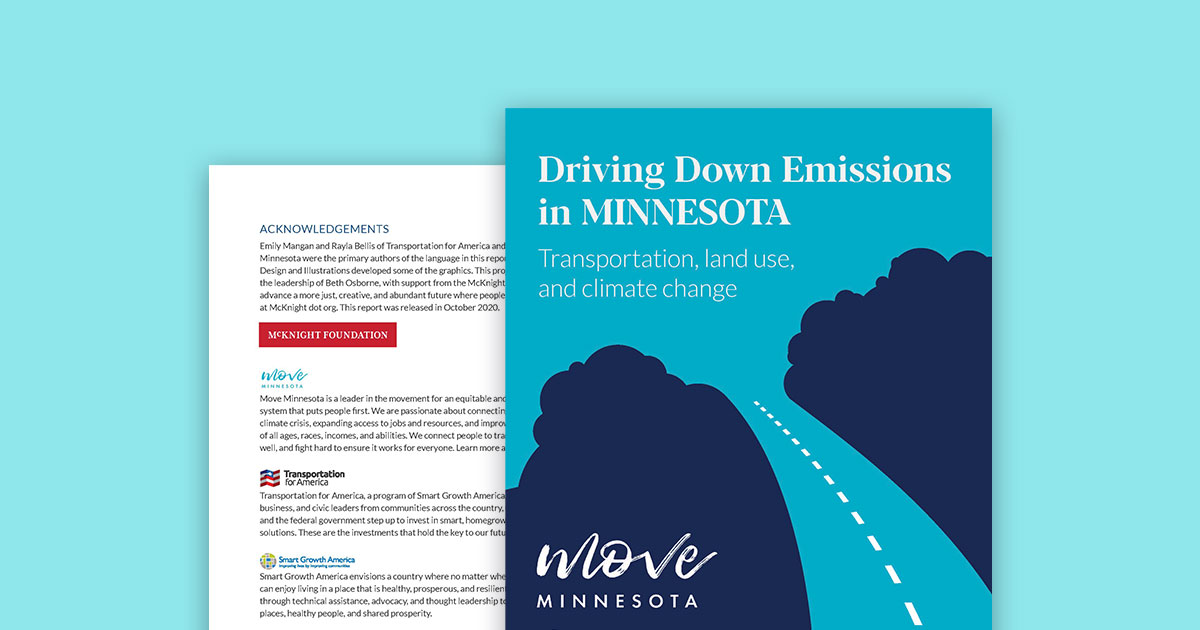New Report: Bold Action Needed on Transportation and Climate in Minnesota
Last month, September 2020, was the hottest September ever recorded on planet Earth. 2020 is projected to be the hottest year on record.
These anecdotes are just the latest in a long line of stories about record-breaking temperatures caused by climate change. Rising temperatures—and the fires, floods, migrations, and crop failures associated with them—will only increase without dramatic action to reduce climate pollution.
It is with this need for action in mind that Move Minnesota and Transportation for America release our new report: Driving Down Emissions in Minnesota. This report serves as a case study for Transportation for America’s national report Driving Down Emissions, which also includes contributions from Move Minnesota. The companion reports were created with support from the McKnight Foundation.
Together, the reports delve into the causes of climate change, review climate pollution trends in the transportation sector, and deliver national and Minnesota-specific recommendations for dramatically reducing transportation pollution.
Climate Change Hits Home in Minnesota
Minnesota, like everywhere, is experiencing an unstable, warming climate. Our winters are particularly vulnerable, with winters in Minneapolis warming 3.3 degrees since just 1970. That makes Minneapolis the second fastest warming city in the United States. As the top source of climate pollution in Minnesota, transportation is a big part of the problem. Cars and light trucks contribute the majority of these emissions.
To reduce climate pollution from transportation, Minnesota needs to both clean up the cars on the road and create a transportation system that reduces incentives to drive.
To date, Minnesota has actually done somewhat better than the country as a whole in terms of driving rates: our per capita vehicle miles traveled (VMT)—the amount each of us drives each year—has gone down about 3.5% in recent years, and emissions have also dropped. However, with a growing population, our combined VMT has gone up.
To stop the climate crisis, small, incremental change isn’t good enough. Staying the course with slight decreases to vehicle miles traveled and inching down emissions leaves warming and destabilizing trends in place.
Even Minnesota state and city climate targets demand more:
- The City of Minneapolis established an overall 80% greenhouse gas emissions reduction target by 2050 and determined that a 38% reduction in driving rates would be necessary to achieve that goal;
- The City of Saint Paul established a 100% greenhouse gas emissions reduction target by 2050 and determined that a 50% reduction in driving would be necessary to achieve that goal; and
- The state’s Next Generation Energy Act articulated an 80%-by-2050 overall goal but did not set a driving reduction target.
How Our State Can Make a Difference
To achieve stability, decision-makers must take fast and significant action. Driving Down Emissions in Minnesota recommends that the State of Minnesota:
- Update climate targets to reflect current realities and set firm and bold targets for VMT reduction that overshoot overall climate goals;
- Stop expanding highway capacity and invest in fast, reliable transit that actually provides a viable alternative to driving;
- In conjunction with the Metropolitan Council, incentivize development in center cities rather than exurbs; and
- Continue to invest in walkable, bikeable downtowns across the state.
Changing the System Starts Now
Our collective inaction on climate change has cost us. If we had begun to reduce emissions at the turn of the century, we would have had about 30 years to cut those emissions in half. Now, if we start immediately, we have about 10 years. If we delay until 2025, we’ll have mere months.
This problem is systemic. It isn’t about making Minnesotans feel bad for getting in the car this morning. Our delay to date has been driven by decision-makers’ lack of political will and by bad actors—including in the transportation sector—actively working against climate progress. In fact, an investigation from E&E News revealed Monday that “scientists at two of America’s biggest automakers knew as early as the 1960s that car emissions caused climate change… [but] by the 1980s and 1990s, the auto industry was involved in efforts to undermine climate science and stop progress to address climate change.”
But there is no question of what we need to do to preserve our climate today. Every single decision, every single week, is crucial. Minnesota must begin cutting emissions, and VMT, right now. That means we must electrify AND make it easy for people to drive less.
There are climate solutions right in front of us. There’s still time to act. Let’s get to work, Minnesota.

